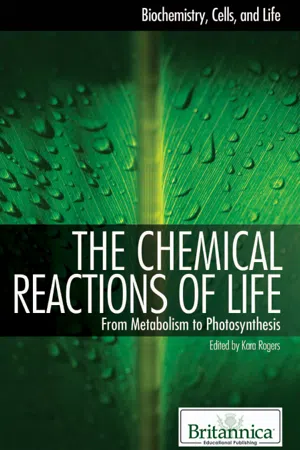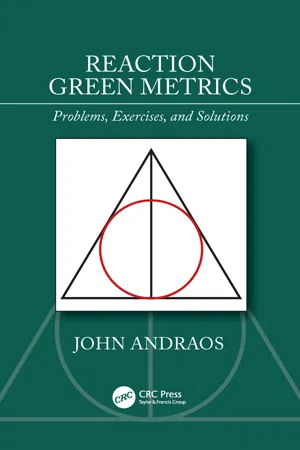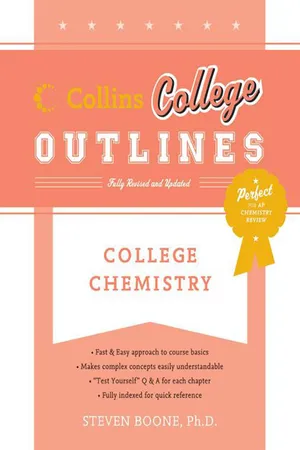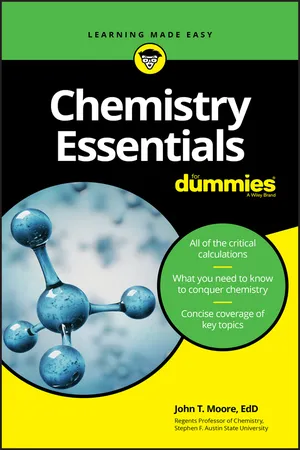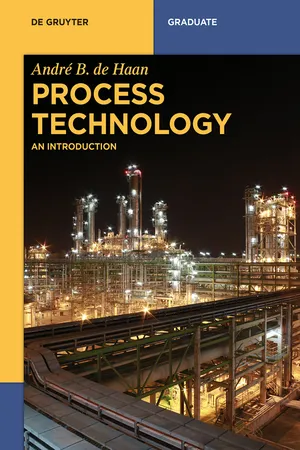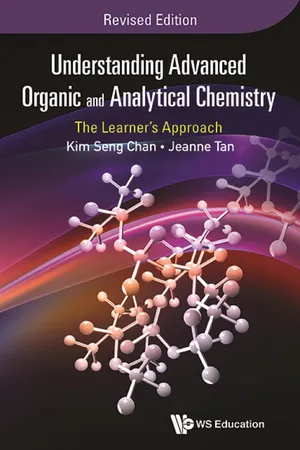Chemistry
Types of Chemical Reactions
Chemical reactions can be classified into several types, including synthesis, decomposition, single displacement, double displacement, and combustion reactions. Synthesis reactions combine two or more substances to form a new compound, while decomposition reactions break down a compound into its constituent elements. Single displacement reactions involve an element replacing another in a compound, and double displacement reactions involve the exchange of ions between two compounds. Combustion reactions involve the rapid combination of a substance with oxygen, often producing heat and light.
Written by Perlego with AI-assistance
Related key terms
Related key terms
1 of 4
Related key terms
1 of 3
8 Key excerpts on "Types of Chemical Reactions"
- eBook - ePub
The Chemical Reactions of Life
From Metabolism to Photosynthesis
- Britannica Educational Publishing, Kara Rogers(Authors)
- 2010(Publication Date)
- Britannica Educational Publishing(Publisher)
CHAPTER 2Classifying and Studying Chemical ReactionsC hemical reactions are an integral part of life and technology. They determine the appearance and behaviour of organisms and the processes by which foods, plastics, and other products are manufactured. Thus, the ongoing study of reactions is fundamental to both the development of new technologies and the further elucidation of the complicated processes that support living systems.Knowledge of the basic properties and mechanisms of chemical reactions also influences the way in which chemists group and categorize reactions. Reactions can be broadly classified as syntheses, decompositions, or rearrangements, or they can be additions, eliminations, or substitutions. Examples include oxidation-reduction, polymerization, ionization, combustion (burning), hydrolysis, and acid-base reactions.CLASSIFYING CHEMICAL REACTIONS
Chemists classify reactions in a number of ways: (a) by the type of product, (b) by the types of reactants, (c) by reaction outcome, and (d) by reaction mechanism. Often, a given reaction can be placed in two or even three categories.CLASSIFICATION BY TYPE OF PRODUCTThe final forms taken by reactants at the end of a chemical reaction are defined as the reaction products. Different reaction pathways result in the formation of different products. Major groups of chemical reactions, categorized on the basis of product type, include gas-forming reactions and precipitation reactions.GAS -FORMING REACTIONSMany reactions produce a gas such as carbon dioxide, hydrogen sulfide (H2 S), ammonia (NH3 ), or sulfur dioxide (SO2 ). An example of a gas-forming reaction is that which occurs when a metal carbonate such as calcium carbonate (CaCO3 - Mark Kernion, Joseph A. Mascetta(Authors)
- 2021(Publication Date)
- Barrons Educational Services(Publisher)
PART VCHEMICAL REACTIONS
Passage contains an image
8 CHEMICAL REACTIONS AND THERMOCHEMISTRY
WHAT YOU WILL LEARN
Upon completing this chapter, you will be able to:•Identify the driving force for these four major Types of Chemical Reactions and write balanced equations for each: combination (or synthesis), decomposition (or analysis), single replacement, and double replacement•Explain hydrolysis using a balanced equation •Identify and explain graphically enthalpy changes in exothermic and endothermic reactions •Use Hess’s Law to show the additivity of heats of reactions •Calculate enthalpy from bond energies
The many kinds of reactions you may encounter can be placed in four basic categories: combination, decomposition, single replacement, and double replacement.Types of ReactionsThe first type, combination, can also be called synthesis. This means the formation of a compound from the union of its elements. Some examples of this type areThe second type of reaction, decomposition, can also be referred to as analysis. This means the breakdown of a compound to release its components as individual elements or other compounds. Some examples of this type areThe third type of reaction is called single replacement or single displacement. This type can best be shown by examples in which one substance is displacing another. Some examples areThe last type of reaction is called double replacement or double displacement because there is an actual exchange of “partners” to form new compounds. Some examples of this arePredicting ReactionsOne of the most important topics of chemistry deals with the reasons why reactions take place. Taking each of the above types of reactions, let us see how a prediction can be made concerning how the reaction gets the driving force to make it occur.COMBINATION (SYNTHESIS)The best source of information in predicting a chemical combination is the heat of formation table. A heat of formation table gives the number of calories evolved or absorbed when a mole (gram-formula mass) of the compound in question is formed by the direct union of its elements. In this book, a positive number indicates that heat is absorbed, and a negative number that heat is evolved. It makes some difference whether the compounds formed are in the solid, liquid, or gaseous state. Unless otherwise indicated (g = gas, ℓ = liquid), the compounds are in the solid state. The values given are in kilojoules; 4.18 joules is the amount of heat needed to raise the temperature of 1 g of water one degree on the Kelvin scale. The symbol ΔH- eBook - ePub
Foundations for Teaching Chemistry
Chemical Knowledge for Teaching
- Keith S. Taber(Author)
- 2019(Publication Date)
- Routledge(Publisher)
Charge and mass (and indeed the elements present in some form) are always conserved in chemical change, and so oxidation and reduction are always balanced (thus, ‘redox’) in an overall chemical reaction whether we focus on oxygen, hydrogen, formal charges, or oxidation numbers. Although there is consistency across definitions in cases when we can apply several of these approaches to analyse a reaction – in whether a reaction is redox, and which species are oxidised and which reduced – there is again a sense that, as with acids, the way chemists conceptualise redox is not simply based on a clear and obvious pattern found in nature.Other reactions
Other reaction types met in school chemistry include binary synthesis (forming a compound by reacting two elements); decomposition (for example when a metal carbonate is heated, giving a metal oxide); precipitation (as when a low solubility salt such as lead iodide is formed by reacting solutions in which solvated lead and iodide ions are present – see Chapter 4 , and above); addition reactions (such as adding species across a double bond); and substitution reactions (as when chlorine replaces iodine in an iodide – see also below).There are also some named reactions that advanced students may read about, such as Grignard reactions and Friedel-Crafts reactions, that are used in synthesising complex organic molecules. The degree of specificity of such types of reactions varies considerably (e.g., a great many reactions count as redox reactions), and it is helpful to realise that grouping substances and reactions into classes is often based on what is useful to chemists – and there are many other possible groupings that could be imagined but which have not (yet!) proved valuable ways of classifying and conceptualising the chemistry that either occurs naturally or has been initiated in laboratories.Reaction mechanismsA chemical equation represents the elemental composition of reactants and products in a chemical reaction. In the example of the combustion of methane, we know that the reactants are of the form of molecules of the hydrocarbon compound methane (CH4 ) and diatomic molecules of the element oxygen (O2 ) and the products are molecular water (H2 O) and carbon dioxide (CO2 - eBook - ePub
Reaction Green Metrics
Problems, Exercises, and Solutions
- John Andraos(Author)
- 2018(Publication Date)
- CRC Press(Publisher)
4 Chemical Reaction Classifications4.1 IdentifyingTypes ofReactionsThere are five major classes of chemical reaction types encountered in organic chemistry: additions, eliminations, rearrangements, redox reactions, and substitutions. Every organic reaction that has ever been discovered or will be discovered in the future can be slotted in at least one of these categories. Generally, most of the named organic reactions that form the workhorse toolbox for organic chemists are categorized uniquely into one of these classes. Modern reactions have attributes that have features of more than one of these classes. Each of these reaction classes may be depicted using a visual algebraic approach using LEGO®-like cartoons to illustrate what is occurring.4.1.1 Terms, Definitions, and Examples Additions Addition reactions involve coupling of two or more components in an acyclic (linear) or a cyclic sense. The visual algebraic operation is addition. Eliminations (Fragmentations) Eliminations or fragmentations involve the splitting apart of a substrate or an intermediate. The visual algebraic operation is subtraction. Multi-ComponentMulti-component reactions are a special sub-class of addition reactions involving at least three substrate structures combining together to produce a product. The order of addition of those substrates may or may not matter depending on the reaction mechanism. This is the most powerful method of constructing ring-containing compounds with the least number of reaction steps.RearrangementsRearrangement reactions involve a reshuffling of atom connectivity of the substrate or a reaction intermediate. The visual algebraic operation is reshuffling. Rearrangements of substrates always have 100% atom economy. Reactions involving rearrangements of transient intermediates always have atom economies less than 100% since by-products always arise. - No longer available |Learn more
- Steven Boone, Drew H. Wolfe(Authors)
- 2011(Publication Date)
- Collins Reference(Publisher)
CHAPTER 5Introduction to Chemical Reactions
I n this chapter, we begin our study of inorganic chemical reactions and solution stoichiometry. The first section introduces the general types of inorganic reactions. The second section covers precipitation reactions—those in which a solid insoluble substance forms. In the final two sections, acid-base and oxidation-reduction reactions are considered.5.1 INORGANIC REACTIONSDetermining patterns in chemical reactions will permit prediction of the reaction products. Classification of Inorganic Reactions Inorganic reactions may be subdivided into four major types.Combination reaction in which two substances combine: A + X → AX. Decomposition reaction; the reverse of a combination reaction: AX → A + X. Single replacement reaction in which an element replaces another element that is part of a compound: A + BX → AX + B. Metathesis or double replacement in which elements in different compounds replace each other: AX + BY → AY + BX.Combination Reactions (A + X → AX)A combination reaction occurs when two substances join and form a compound. The general equation for all combination reactions is:A + X → AXin which A and X are either elements or compounds and AX is a compound. Some common types of combination reactions include metal oxide formation. A metal oxide forms when a metal undergoes a combination reaction with a nonmetal. For example, when calcium, Ca(s), reacts with oxygen gas, O2 (g), solid calcium oxide, CaO(s), results.2Ca(s) + O2 (g) → 2CaO(s)Another example is base formation combination reaction. Metal oxides undergo a combination reaction with water to produce bases. A base is a compound that increases the OH- (aq) ion concentration in aqueous solutions. For example, the base sodium hydroxide, NaOH, forms from sodium oxide, Na2 O(s), and H2 O(1).Na2 O(s) + H2 O(1) → 2NaOH(aq)A final example of a combination reaction is acid formation combination reaction. An acid forms from the combination reaction of a nonmetal oxide and water. An acid is a compound that increases the H+ (aq) ion concentration in aqueous solutions. For example, sulfuric acid, H2 SO4 , results when gaseous sulfur trioxide, SO3 - eBook - ePub
- John T. Moore(Author)
- 2019(Publication Date)
- For Dummies(Publisher)
Chapter 7Chemical Reactions
IN THIS CHAPTERDifferentiating between reactants and productsFinding out how reactions occurTaking a look at types of reactionsUnderstanding how to balance reactionsFiguring out chemical equilibriumChecking out speeds of reactionIn a chemical reaction, substances (elements and/or compounds) are changed into other substances (compounds and/or elements). You can’t change one element into another element in a chemical reaction — that happens in nuclear reactions, as I describe in Chapter 4 .A number of clues show that a chemical reaction has taken place — something new is visibly produced, a gas is created, heat is given off or taken in, and so on.In this chapter, I discuss chemical reactions — how they occur and how to write a balanced chemical equation. I also tell you about chemical equilibrium and explain why chemists often can’t get the amount of product out of a reaction that they thought they could. And finally, I discuss the speed of reaction.Reactants and Products: Reading Chemical Equations
You create a new substance with chemical reactions. The chemical substances that are eventually changed are called the reactants, and the new substances that are formed are called the products .Chemical equations show the reactants and products, as well as other factors such as energy changes, catalysts, and so on. With these equations, you use an arrow to indicate that a chemical reaction has taken place. Beneath or above this arrow people sometimes indicate that a specific catalyst is used, or acidic conditions or heat is applied, and so on. In general terms, a chemical reaction follows this format:For example, take a look at the reaction that occurs when you light your natural gas range in order to fry your breakfast eggs. Methane (natural gas) reacts with the oxygen in the atmosphere to produce carbon dioxide and water vapor. (If your burner isn’t properly adjusted to give that nice blue flame, you may also get a significant amount of carbon monoxide along with carbon dioxide.) You write the chemical equation that represents this reaction like this: - eBook - ePub
- André B. de Haan(Author)
- 2015(Publication Date)
- De Gruyter(Publisher)
chemical reaction engineers.3.2 Classification of reactions
There are many ways of classifying chemical reactions. In chemical reaction engineering probably the most useful scheme is a breakdown according to the number and types of phases involved, the big division being between homogeneous and heterogeneous systems. A reaction is homogeneous if it takes place in one phase alone. A reaction is heterogeneous if it requires the presence of at least two phases to proceed at the rate that it does. It does not matter whether the reaction takes place in one, two, or more phases, or at an interface, or whether the reactants and products are distributed among the phases or are all contained within a single phase. All that counts is that at least two phases are necessary for the reaction to proceed as it does.Sometimes this classification is not as clear cut as with the large class of biological reactions, the enzyme substrate reactions. Since enzymes themselves are highly complicated proteins of large molecular weight and colloidal size, enzyme-containing solutions represent a gray region between homogeneous and heterogeneous systems. Another example for which the distinction is not sharp is a very rapid chemical reaction, such as a burning gas flame, where large nonhomogeneity in composition and temperature may exist.Cutting across this classification is the catalytic reaction whose rate is altered by materials which are neither reactants nor products. These foreign materials, called catalysts, need not be present in large amounts. Catalysts act somehow as gobetweens, either hindering or accelerating the reaction process while being modified relatively slowly if at all.Tab. 3.1 - eBook - ePub
Understanding Advanced Organic and Analytical Chemistry
The Learner's ApproachRevised Edition
- Kim Seng Chan, Jeanne Tan;;;(Authors)
- 2016(Publication Date)
- WS EDUCATION(Publisher)
CHAPTER 3
Organic Reactions and Mechanisms
3.1 Introduction
What is a chemical reaction? You would say that it is a process whereby substances interact and transform into new ones, usually with different properties. How does the transformation occur? Do the reactant molecules simply collide with each other and therefore combine to form new compounds? If this is so, why do certain reactions occur only when appropriate conditions such as heating or catalyst are imposed?A classical view of chemical reactions involves the rearrangement of particles (atoms, ions or molecules), and for this to occur, “old” bonds are broken before “new” bonds are formed. But these rearrangements do not happen by simply bumping molecules around, even though collision is a precursor for a fruitful reaction. When two reacting particles approach each other, there is repulsion between their negatively charged electron clouds. This repulsive force decreases the speed of the approaching particles while they are colliding with each other. If they do not have sufficient kinetic energy to overcome the repulsive force that tries to keep them apart, by the time they “touch” each other, they would simply be “pushed” apart. In such an instance, bonds are neither broken within a particle nor formed between them.Let us try a different scenario. This time round, when the approaching particles have sufficient kinetic energy, effectively known as the activation energy (Ea ), they can overcome the repulsive force, which then leads to the inter-penetration of their electron clouds. At this juncture, there can be rearrangement of valence electrons, with the partial breaking of old bonds and the partial formation of new ones — this fuzzy picture is aptly described as the formation of an activated complex in the transition state. In the energy profile diagram (see Fig. 3.1
Index pages curate the most relevant extracts from our library of academic textbooks. They’ve been created using an in-house natural language model (NLM), each adding context and meaning to key research topics.
Explore more topic indexes
Explore more topic indexes
1 of 6
Explore more topic indexes
1 of 4
